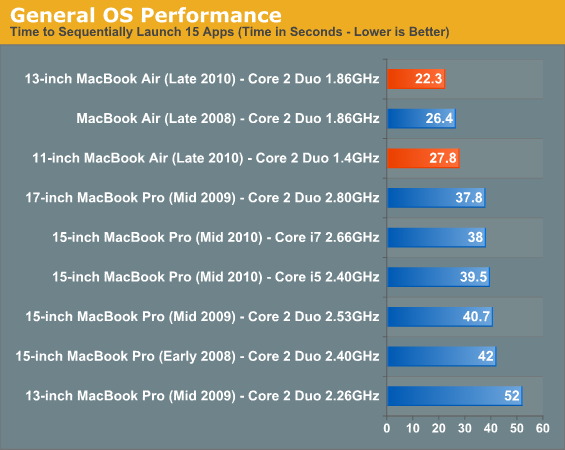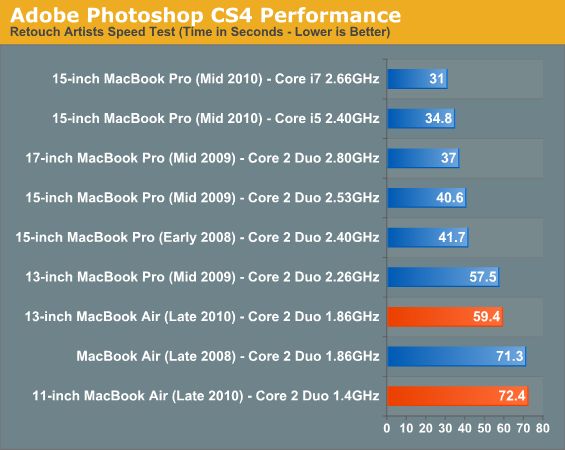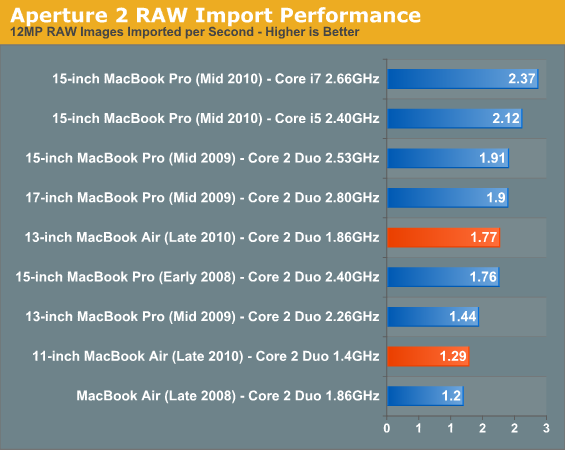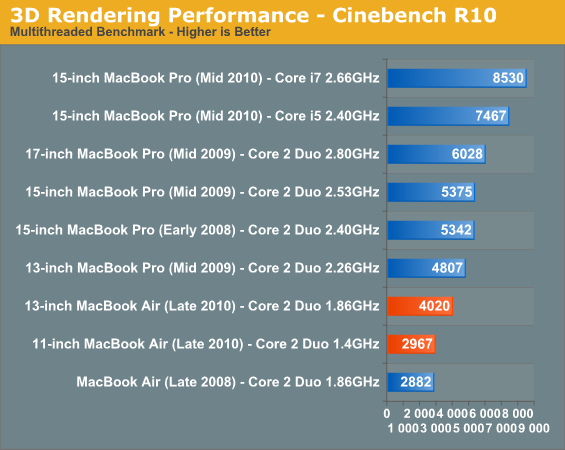Apple's 2010 MacBook Air (11 & 13 inch) Thoroughly Reviewed
by Anand Lal Shimpi on October 26, 2010 10:08 PM EST- Posted in
- Mac
- Apple
- MacBook Air
- Laptops
Performance
Benchmarking under OS X isn’t difficult, you just need to get creative. Luckily I’m in dire need of creative outlets so creating OS X benchmarks works for me. I’m using the same tests I introduced in my Holiday 2009 Macbook Pro roundup and running on the launch hardware for each notebook listed in the charts.
We’ll start with general application performance.
General OS usage is a difficult thing to quantify, but one measure of performance has always been the number of bounces an icon in the dock makes before an application loads. I decided to take it to the next level and write a quick script to launch 15 applications in a row, timing how long the entire process takes.
I launched, in order: Mail, Safari, Activity Monitor, iTunes, iCal, DVD Player, iPhoto, Photo Booth, Quicktime Player, Disk Utility, Preview, iMovie, Front Row, Garage Band and Aperture.
The entire process stresses both the disk and CPU, which is why we see a huge improvement when going to an SSD as well as differences between CPU speeds.

What a difference an SSD can make. The 13-inch MacBook Air is the fastest standard shipping configuration Apple offers in this benchmark. The fact that there's a measurable difference between the 13-inch and 11-inch models shows you just how slow that 1.4GHz Core 2 really is.
Adobe Photoshop CS4 Performance
The Retouch Artists Speed Test we use for our CPU testing under Windows also works under OS X. We're running the exact same benchmark here, basically performing a bunch of image manipulations and filters and timing the entire process.

The 13-inch MacBook Air performs as well as last year's 13-inch MacBook Pro. But if you plan on doing real work, you'll be hampered by the performance of these systems. Apple really needs to find a way to get an Arrandale or Sandy Bridge into this chassis
Aperture 2 RAW Import
For my Aperture test I simply timed how long it took to import 203 12MP RAW images into the library.

The SSD makes the 13-inch MacBook Air far more competitive than it should be here. It's even faster than a two year old 15-inch MacBook Pro. The 11-inch MBA is faster than the old 13-inch MBA due to its better thermal characteristics as we pointed out earlier.
Cinebench R10
I’m a fan of the Cinebench test because it lets me show off both single and multithreaded performance in the same workload. First, the single threaded performance:


The performance in both of these tests in line with the rest of the results. These notebooks aren't very good at intensive workloads. It is worth pointing out that the 13-inch MacBook Air posts better numbers here than the old dual processor 2.5GHz PowerMac G5 :)
Quicktime H.264 Video Encoding
Our final benchmark is more consumer focused. Here I'm taking an XviD and converting it to an iPhone-supported H.264 format.











185 Comments
View All Comments
nvidia2008 - Wednesday, October 27, 2010 - link
Great article, just one niggle, Instant On does not refer to Boot, nor Wake From Sleep.From the Apple website:
"And when you put MacBook Air to sleep for more than an hour, it enters what’s called standby mode. So you can come back to MacBook Air a day, a week - even up to an entire month later - and it wakes in an instant."
http://www.apple.com/macbookair/design.html
Instant On refers to a Standby Mode (basically hibernate) that is not Boot nor Wake From Sleep.
AMDJunkie - Wednesday, October 27, 2010 - link
This is a good point; Macs with hard drives have "deep sleep" standby, which is the typical, "Hey, your battery is about to die so we're taking the system state from RAM to the hard drive" hibernation. This is an SSD, though, so I presume it writes it to the SSD after an hour, instead of after your battery dips under 5%, to help you save battery.nvidia2008 - Wednesday, October 27, 2010 - link
Yeah, I think Deep Sleep is the most closely related thing to Instant On, not Boot or Wake From Sleep. Cheershechacker1 - Wednesday, October 27, 2010 - link
OS-X, when put to sleep by closing the lid, will write out the necessary parts of memory to the hard drive.Then if your battery dies, the hibernate state resumes when you plug it back in.
If you have a ton of applications open and are using a lot of ram before closing the lid, it does take noticeably longer to actually begin sleep and turn off the HD, as indicated by the light on the macbook.
tipoo - Wednesday, October 27, 2010 - link
Yeah, Instant On is really just fast-wake-from-hibernate.Tuntavern - Wednesday, October 27, 2010 - link
Now there ARE two.ginny - Wednesday, October 27, 2010 - link
HiYou had said that your macbook air was using about 1.4 gb of memory when diting a handful of imgs in Photoshop. Do you think then that it isnt the best machine to get if I anticipate in using Adobe CS frequently? Do you think i should opt for a MBP instead? Or will upgrading the CPU and Memory suffice?
Thanks!
zhill - Wednesday, October 27, 2010 - link
Good review. I was waiting for you guys to review the new airs, good data. FYI, your images comparing the 13" MBA's size appear to be labeled incorrectly. I think the image (http://images.anandtech.com/reviews/mac/macbookair... is comparing the MBA 13" to the MBP 15" rather than the MBP 13".I'm also surprised that the screens had such a limited color gamut, I expected something in the 70% range rather than 40% but I suppose they trade that for energy efficiency(?).
I would be very curious to see your benchmarks include a new air with the 2.13GHz C2D and 4GB RAM to compare that to the the 1.86Ghz. I seem to recall that the last generation 2.13Ghz Air had even more thermal throttling issues than the lower spec chip so I wonder if it has been addressed in that configuration as well.
Any ideas on how they achieved such a fast wake time compared with the MBP 15" w/SSD? Typically, a sleep/wake operation is not very dependent upon the disk as the memory is kept powered so the system state should easily be restored without much disk access. Interesting stuff.
dsee15 - Wednesday, October 27, 2010 - link
Great Review, thank you!How much faster do you think the 13 MBA with 2.1Ghz proc, 4GB Mem, 256GB SSD would be over the stock model you tested? Do you think the faster proc will generate too much heat and initiate the governor?
How would this 'tricked out' system run VMware/windows/office?
Lastly, it appears the tricked out version could out perform both the 13 MB aluminum with hard drive and 13 MBP with hard dive, except for the most cpu intensive apps, agree...??? Could it replace a 15 MBP with hard drive?
doubledown21 - Wednesday, October 27, 2010 - link
Will there be any updates to the benchmarks if/when the 2.13GHz MBA is tested?